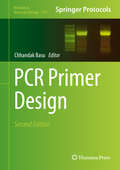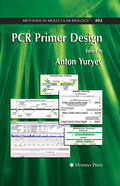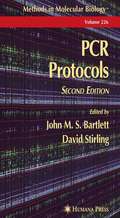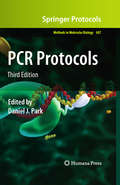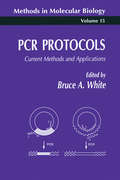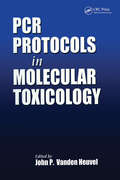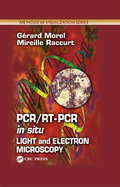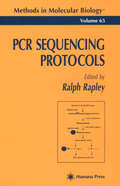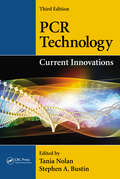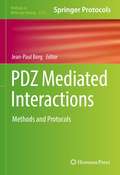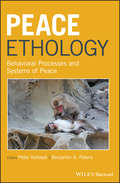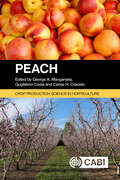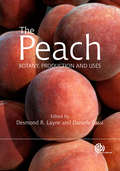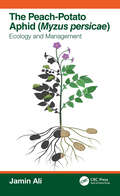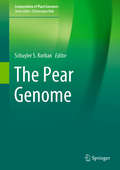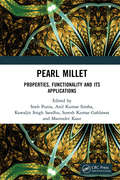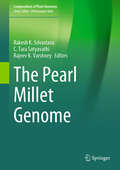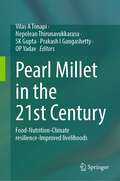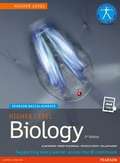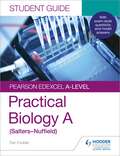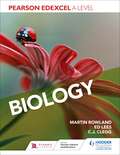- Table View
- List View
PCR Primer Design
by Chhandak BasuThis volume provides an overview on design PCR primers for successful DNA amplification. Chapters focus on primer design strategies for quantitative PCR, in silico PCR primer design, and primer design using software. Written in the highly successful Methods in Molecular Biology series format, chapters include introductions to their respective topics, lists of the necessary materials and reagents, step-by-step, readily reproducible laboratory protocols, and tips on troubleshooting and avoiding known pitfalls. Authoritative and easily accessible, PCR Primer Design, Second Edition seeks to aid molecular biology students, researchers, professors and PCR enthusiasts.
PCR Primer Design
by Anton YuryevAt the heart of most high-throughput methods is the technique of polymerase chain reaction (PCR). This book focuses on primer design, which is critical to both the efficiency and the accuracy of the PCR. With intricate descriptions of basic approaches as well as specialized methods, "PCR Primer Design" is an exceptional reference for all those involved in studying the genome.
PCR Protocols
by John M. Bartlett David StirlingIn this new edition, the editors have thoroughly updated and dramatically expanded the number of protocols to take advantage of the newest technologies used in all branches of research and clinical medicine today. These proven methods include real time PCR, SNP analysis, nested PCR, direct PCR, and long range PCR. Among the highlights are chapters on genome profiling by SAGE, differential display and chip technologies, the amplification of whole genome DNA by random degenerate oligonucleotide PCR, and the refinement of PCR methods for the analysis of fragmented DNA from fixed tissues. Each fully tested protocol is described in step-by-step detail by an established expert in the field and includes a background introduction outlining the principle behind the technique, equipment and reagent lists, tips on trouble shooting and avoiding known pitfalls, and, where needed, a discussion of the interpretation and use of results.
PCR Protocols
by Daniel J. ParkKnown for flexibility and robustness, PCR techniques continue to improve through numerous developments, including the identification of thermostable DNA polymerases which exhibit a range of properties to suit given applications. PCR Protocols, Third Edition selects recently developed tools and tricks, contributed by field-leading authors, for the significant value that they add to more generally established methods. Along with the cutting-edge methodologies, this volume describes many core applications, such as PCR cloning and sequencing, expression, copy number or methylation profile analysis, 'DNA fingerprinting', diagnostics, protein engineering, interaction screening as well as a chapter highlighting workflow considerations and contamination control, crucial for all PCR methods. Written in the highly successful Methods in Molecular BiologyTM series format, chapters include introductions to their respective topics, lists of the necessary reagents and materials, step-by-step, readily reproducible laboratory protocols, and tips on troubleshooting and avoiding known pitfalls. Authoritative and up-to-date, PCR Protocols, Third Edition seeks to further elucidate this essential technique while also providing core principles with broad applications for scientists of all backgrounds.
PCR Protocols
by Bruce A. WhiteThe newest and most up-to-date collection, PCR Protocols offers detailed laboratory procedures for the use of polymerase chain reactions in a wide range of applications. Although specific examples and experimental systems are described, the book's focus is on general applications that can be modified to suit a broad spectrum of research systems, thus making its scope appealing to nearly all researchers. PCR Protocols features clear, easy-to-follow descriptions of procedures and a Notes section in each chapter to provide tips, alternative suggestions, and other enhancements of the protocols. Key Topics and Techniques: basic startup procedures for PCR * PCR in detecting DNA and RNA * PCR in DNA synthesis and mutagenesis * PCR cloning of DNA * selection of primers * radioactive and nonradioactive labeling * quantitation of PCR products by HPLC * chromosome assignment * PCR mapping of HLA genes * sequencing of PCR products * genomic footprinting * quantitation of tumor gene expression * screening of phage libraries * SSP-PCR and genome walking * subcloning of PCR products.
PCR Protocols in Molecular Toxicology (Methods in Life Sciences - Toxicology Section)
by John P. Vanden HeuvelMolecular toxicology is an emerging discipline that utilizes molecular and cell biology to understand how drugs and chemicals result in their unwanted effects. PCR Protocols in Molecular Toxicology is a practical guide to the use of polymerase chain reaction (PCR) to help examine, on a molecular and cellular level, how toxic responses are manifested. It offers a basic understanding of PCR and its optimization, as well as describing specific, high-impact areas of molecular toxicology and recent advances. The following techniques are described in detail: Quantitative reverse transcriptase PCR and methods to examine gene expression Differential display cloning Cloning and library screening by PCR Genotype and polymorphism analysis of drug and toxicant metabolizing enzymes Basic, non-PCR based molecular biology methods PCR Protocols in Molecular Toxicology will aid both novices and experienced PCR practitioners in using PCR to its fullest potential.
The PCR Revolution: Basic Technologies and Applications
by Stephen A. BustinThe invention of the polymerase chain reaction (PCR) won the Nobel Prize in Chemistry in 1994 and remains one of the most important scientific discoveries of the twentieth century. More than 50,000 researchers in the United States use PCR replication technology, and yet a book has not been published on the subject in more than ten years. In this book, Dr. Stephen A. Bustin, a world-renowned PCR expert, examines in detail the latest innovations and the overall impact of PCR on many areas of molecular research. The book contains personal reflections, opinions, and comments by leading authorities on the many applications of the PCR and how this technology has revolutionized their respective areas of interest. This book conveys the ways in which PCR has overcome many obstacles in life science and clinical research and also charts the PCR's development from time-consuming, low throughput, non-quantitative procedure to today's rapid, high throughput, quantitative super method.
PCR/RT- PCR in situ: Light and Electron Microscopy (Methods in Visualization)
by Gerard Morel Mireille RaccurtAlthough the polymerase chain reaction has revolutionized genetic analysis by amplifying rare nucleic acid sequences, the in situ application is the only method that allows the localization of amplified signal within tissue structure. The applications of in situ polymerase chain reaction have greatly enhanced the field of investigation in many disc
PCR Sequencing Protocols
by Ralph RapleyA superb, comprehensive collection of the most reliable protocols for PCR sequencing-all developed and described by eminent researchers and scientists who use them successfully every day. These protocols deal practically with those problems accompanying the rapid reassociation of amplified complementary strands by showing how sequencing reactions may be effectively modified, as well as complex methods of primer manipulation that enable the affinity purification, or its transcript production, of homogeneous single strands. They also provide all the necessary details of PCR purification, primer labeling, the preparation of sequencing gels, as well as of conventional methods for cloning PCR products into vectors and their subsequent sequencing.
PCR Technology: Current Innovations, Third Edition
by Tania Nolan Stephen A. BustinPCR's simplicity as a molecular technique is, in some ways, responsible for the huge amount of innovation that surrounds it, as researchers continually think of new ways to tweak, adapt, and re-formulate concepts and applications. PCR Technology: Current Innovations, Third Edition is a collection of novel methods, insights, and points of view that
PDZ Mediated Interactions: Methods and Protocols (Methods in Molecular Biology #2256)
by Jean-Paul BorgThis volume provides readers with a comprehensive look at the latest techniques used to identify and characterize PDZ-mediated interactions. Chapters cover topics such as promiscuity, multimodularity, regulation, and viral recognition by PDZ domains. Written in the highly successful Methods in Molecular Biology series format, chapters include introductions to their respective topics, lists of the necessary materials and reagents, step-by-step, readily reproducible laboratory protocols, and tips on troubleshooting and avoiding known pitfalls.Cutting-edge and thorough, PDZ Mediated Interactions: Methods and Protocols is a valuable resource for all researchers interested in learning more about this developing field.
Peace Ethology: Behavioral Processes and Systems of Peace
by Peter Verbeek Benjamin A. PetersA scholarly collection of timely essays on the behavioral science of peace With contributions from experts representing a wide variety of scholarly fields (behavioral and social sciences, philosophy, environmental science, anthropology and economics), Peace Ethology offers original essays on the most recent research and findings on the topic of the behavioral science of peace. This much-needed volume includes writings that examine four main areas of study: the proximate causation of peace, the developmental aspects of peace, the function and systems of peace and the evolution of peace. The popular belief persists that, by nature, humans are not pre-disposed to peace. However, archeological and paleontological evidence reveals that the vast majority of our time as a species has been spent in small hunter-gatherer bands that are basically peaceful and egalitarian in nature. The text also reveals that most of the earth’s people are living in more peaceful societies than in centuries past. This hopeful compendium of essays: Contains writings from noted experts from a variety of academic studies Offers a social-psychological perspective on the causation of peaceful behavior Includes information on children’s peacekeeping and peacemaking Presents ideas for overcoming social tension between police and civilians Provides the most recent thinking on the behavioral science of peace Written for students and academics of the behavioral and social sciences, Peace Ethology offers scholarly essays on the development, nature, and current state of peace.
Peach (Crop Production Science in Horticulture)
by Maria Luisa Badenes James Adaskaveg B. Anthony Daniele Bassi B. Blaauw C. Bonghi A. Botton M. Cirilli Luis Cisneros-Zevallos M. Christofi B. Dichio M. F. Drincovich P. Drogoudi Gemma Echeverria Helga Förster S. Foschi K. Gasic Daniela Giovannini Thomas M Gradziel I. Iglesias Gregory A Lang J. C. Melgar P. Milonas I. S. Minas B. Morandi M. Á. Moreno A. L. Nielsen Nikolaos T Papadopoulos J. Pieper G. Reig Gregory Reighard David Ritchie S. Sansavini Guido Schnabel P. Tonutti L. Trainotti A. R Vicente C. XiloyannisPeach is a highly valuable temperate fruit crop with significant consumer demand and nutraceutical benefits. This book provides comprehensive and up-to-date coverage on sustainable production processes for peach and nectarine. The latter is a natural mutation of peach that lacks fuzzy skin. It includes fundamental information to help reduce production risks for growers, improve fruit quality, and increase potential market returns, whilst addressing current emerging issues such as climate change and shifting global and regional production practices. Written by an international team of expert authors and highly illustrated in full colour throughout, Peach presents information in an organized and easy-to-follow manner, with content including: Peach tree architecture. Rootstocks. Cultivars. In-field operations (irrigation, fertilization, thinning, harvest) Fruit quality, composition and nutritional benefits. Peach fruit growth, development and ripening physiology. Postharvest technology, including supply chain management protocols. Preharvest and postharvest diseases. Biology and management of insect pests. The peach canning industry. This is an essential resource for students and researchers in horticulture, as well as professionals in pomology including fruit growers, consultants and extension specialists, and cold storage and transportation managers.
Peach
by Angelo Ramina Gregory Reighard Andy Nyczepir Albert Abbott Dan Horton Desmond Layne Bruce Topp Richard Marini Rene Monet Daniele Bassi Tom Gradziel R. Johnson Hongwen Huang Filiberto Loreti Thomas Tworkoski William Okie Mariano Cambra Luca Corelli-Grappadelli James Adaskaveg Carlos Crisosto Theodore DeJong David RitchieThe Peach provides a comprehensive up to date reference work, summarizing our knowledge of peaches and their production worldwide and includes an extensive colour plates section. Chapters written by international authorities address botany and taxonomy, breeding and genetics of cultivars and rootstocks, propagation, physiology and planting systems, crop and pest management and postharvest physiology. The book also includes a contribution on the history of cultivation and production trends in China with historical references dating back to 1100 B.C for the first time in the English language.
The Peach Potato Aphid (Myzus persicae): Ecology and Management
by Jamin AliConsidered as economically significant pests with worldwide distribution, aphids feed on hundreds of cultivated and ornamental plants and cause considerable economic loss on a global scale. The peach-potato aphid, Myzus persicae, is one of the most severe model aphid pests and successfully colonizes hundreds of plant species from 40 different families. It is a complex aphid pest known for its high reproductive rate, biotype formation, suppression of plant defenses, and wide range of host plants. This book covers ecological aspects - including life cycle, damage, and host range - which make aphids an economically important pest. A wide range of topics are covered, including ecological aspects of M. persicae; challenges with management approaches; damage; suppression of plant defenses; evolution; the mechanism of resistance against major classes of insecticides; the potential of biological control and natural plant-derived compounds (plant defense elicitors) as an alternative to the use of synthetic chemical insecticides to control M. persicae; and integrated pest management for M. persicae. As the peach-potato aphid is a model aphid pest, studying it helps to develop control strategies against the entire group of aphids. Written for professionals, as well as students, teachers, and researchers in the fields of entomology, ecology, and bioscience, this book is an enriching new addition to its field.
The Pear Genome (Compendium of Plant Genomes)
by Schuyler S. KorbanAddressing the pear genome, this book covers the current state of knowledge regarding genetic and genomic resources, breeding approaches and strategies, as well as cutting-edge content on how these tools and resources are being / soon will be utilized to pursue genetic improvement efforts that will combine fruit quality, high productivity, precocious fruit bearing, and long postharvest storage life, along with elevated levels of resistance to various major diseases and insect pests. Throughout, the book also explores potential opportunities and challenges in genomic analysis, sequence assembly, structural features, as well as functional studies that will assist in future genetic improvement efforts for pears. The pear (Pyrus), an important tree fruit crop, is grown worldwide, and has several economically relevant cultivars. In recent years, modern genetic and genomic tools have resulted in the development of a wide variety of valuable resources for the pear. In the past few years, completion of whole genome assemblies of ‘Dangshansuli’, an Asian pear, and ‘Bartlett’, a European pear, have paved the way for new discoveries regarding for example, the pear’s genomic structure, chromosome evolution, and patterns of genetic variation. This wealth of new resources will have a major impact on our knowledge of the pear genome; in turn, these resources and knowledge will have significant impacts on future genetic improvement efforts.
Pearl Millet: Properties, Functionality and its Applications
by Sneh Punia Anil Kumar Siroha Kawaljit Singh Sandhu Suresh Kumar Gahlawat Maninder KaurPearl millet is mainly used for animal and poultry feed. It is the principal source of energy, protein, vitamins, minerals and contains many phenolic compounds, which are a good source of natural antioxidants. Pearl millet is a rich source of bioactive compounds and contains phytates and polyphenols. Owing to high nutritional and phytochemical properties, it has gained considerable attention as a botanical dietary supplement in many functional foods. Pearl Millet: Properties, Functionality and Its Applications provides comprehensive knowledge on nutritional and non-nutritional aspects of pearl millet. It covers recent research on pearl millet and provides information to improve the property and shelf life of flour, as well as the starch, and their uses in various food products. Features: Reviews structure, functional and antioxidant properties in pearl millet flour Deals with the latest developments in modification of native starch Provides information in enhancing shelf life and its utilization in phytochemical-rich product development Covers updated information for grain science professionals and food technologists
The Pearl Millet Genome (Compendium of Plant Genomes)
by Rakesh K. Srivastava Rajeev K. Varshney C. Tara SatyavathiThis book entitled, The Pearl Millet Genome, is the first comprehensive compilation of deliberations on history, domestication, genetic and genomic resources, traditional breeding, genetic diversity, molecular maps and mapping of important biotic stress as well as nutritional quality traits, whole genome sequencing and comparative genomics, functional genomics, genetic transformation. The economic, nutritional, and health importance of the pearl millet is also discussed. It also presents the input use efficiency and wide adaptation of the crop. Altogether, the book will contain about 200 pages over 10 chapters authored by globally reputed experts on the relevant field in this crop. This book will be useful to the students, teachers, and scientists in the academia and relevant private companies interested in genetics, pathology, molecular genetics and breeding, genetic engineering, structural and functional genomics, and nutritional quality aspects of the crop. This book will also be also useful to seed and pharmaceutical industries.
Pearl Millet in the 21st Century: Food-Nutrition-Climate resilience-Improved livelihoods
by Vilas A Tonapi Nepolean Thirunavukkarasu Sk Gupta Prakash I Gangashetty Op YadavThis book documents the global pearl millet research for achieving the sustainable development goals in the eve of International Year of Millets in 2023 by FAO. This book offers perspectives on the recent advances in the field of genomics, next-generation breeding approaches, hybrid development, crop production and protection technologies of pearl millets. Pearl millet is the world’s most important millet grown in the hot, semi-arid ecologies of Asia and Africa with versatile end uses. Of all the world’s cereals, pearl millet ranks the sixth most important crop after rice, wheat, maize, barley and sorghum. In the changing climatic condition, it can be pitched as strategic crop for food and nutritional security owing to its ability to survive in harsh ecologies and the higher micro-nutrients grain content. This books focuses on nutritional importance, climate resilience, seed systems, value-addition and market policies to enhance the genetic gain of pearl millets under marginal and favorable ecologies, and way forward for a food and nutrition secure world. It is a useful reading material for researchers and professionals working on small grains, millets and their cultivation and nutrition related aspects.
Pearls and Pitfalls in Emergency Radiology
by Martin L. GunnRapid recognition of life-threatening illnesses and injuries expedites appropriate management and improves clinical outcomes. False-positive interpretations in radiology have been identified as a significant cause of error, leading to unnecessary investigation and treatment, increased healthcare costs, and delays in appropriate management. Moreover, it is important that radiologists do not miss important subtle diagnoses that need urgent intervention. Pearls and Pitfalls in Emergency Radiology provides an outline of common imaging artefacts, anatomic variants and critical diagnoses that the radiologist must master in order to guide appropriate care and avoid malpractice lawsuits. One hundred selected cases – illustrated with several hundred images from MRI, MDCT, PET, ultrasound and radiographs – are presented in a succinct and structured format, highlighting key pearls and potential diagnostic pitfalls. The text focuses on emergent presentations of diseases in all body regions in both adults and children.
Pearson Baccalaureate: Higher Level Biology
by Patricia Tosto Randy Mcgonegal William Ward Alan DamonCompletely revised new editions of the market-leading Biology textbooks for HL and SL, written for the new 2014 Science IB Diploma curriculum.
The Pearson Custom Library for the Biological Sciences: Symbiosis
by Pearson Learning SolutionsBiology 101 Lab Manual. Describes lab experiments.
Pearson Edexcel A-level Biology (Salters-Nuffield) Student Guide: Practical Biology
by Dan FoulderGet to grips with the core practicals and develop the skills students need to succeed with an assessment-driven approach, combining clear summaries of practical work that reinforce understanding, with sample questions and answers to improve exam technique. - Easily identify what students need to know with a concise summary of the required practical work examined in the A-level specifications. - Consolidate understanding of practical work, methodology, mathematical and other skills out of the laboratory with exam tips and knowledge check questions, with answers in the back of the book. - Improve exam technique with sample answers, examiner's tips and exam-style questions. - Provide extra support with coverage of methodologies and generic practical skills not focused on in the textbooks.
Pearson Edexcel A-level Biology (Salters-Nuffield) Student Guide: Practical Biology
by Dan FoulderGet to grips with the core practicals and develop the skills students need to succeed with an assessment-driven approach, combining clear summaries of practical work that reinforce understanding, with sample questions and answers to improve exam technique. - Easily identify what students need to know with a concise summary of the required practical work examined in the A-level specifications. - Consolidate understanding of practical work, methodology, mathematical and other skills out of the laboratory with exam tips and knowledge check questions, with answers in the back of the book. - Improve exam technique with sample answers, examiner's tips and exam-style questions. - Provide extra support with coverage of methodologies and generic practical skills not focused on in the textbooks.
Pearson Edexcel A Level Biology (Year 1 and Year 2)
by Martin Rowland Edward Lees C. J. CleggSupports Pearson Edexcel Level 3 Advanced GCE in Biology B (9BI0) specification.Build investigative skills, test understanding and apply biological theory to topical examples with the updated, all-in-one textbook for Years 1 and 2.Combining everything your students need to know for the Pearson Edexcel A level Biology B specification, this revised textbook will:- Support all 16 required practicals with activities and questions to help students explain procedures, analyse data and evaluate results.- Provide clear definitions, as well as explanations, of the meanings of all technical vocabulary needed for the specification.- Help bring students up to speed with a summary of prior knowledge and diagnostic questions at the start of each chapter.- Offer assessment guidance with exam practice questions at the end of each chapter, graded by difficulty to support progression.- Stretch more able students with new extended response and 'Challenge' questions.- Build mathematical skills with a dedicated 'Maths for Biology' chapter and support throughout, explaining key concepts and methods.- Develop and embed understanding with end-of-chapter summaries, free online access to 'Test yourself' answers and an extended glossary.
